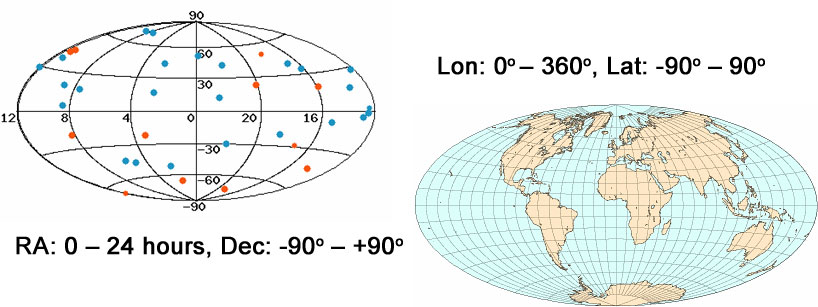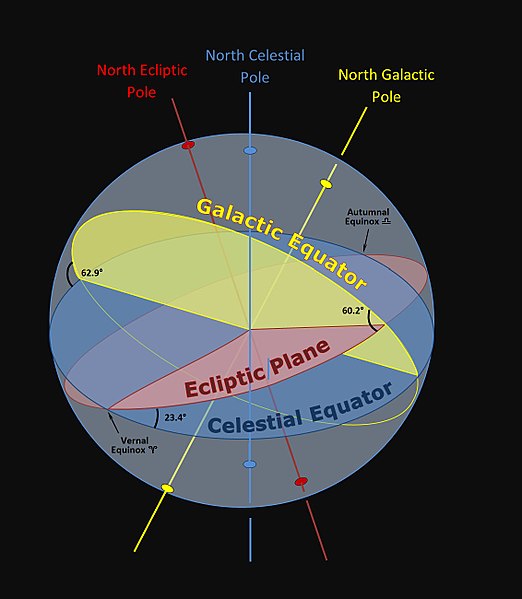Astrometry: the determination of positions in the sky of astronomical objects and how those positions change over time. Astrometry involves making a map of objects in sky.
Coordinate Systems: Measuring the positions of objects requires the use of a coordinate system of some sort. Here we describe three that you are likely to encounter in making or reducing astronomical observations.
Equatorial Coordinate System: The Equatorial coordinate system is one of the preferred coordinate systems of observational astronomers. The Equatorial coordinate system, like latitude and longitude, is based on measures of angular separation from some arbitrary origin; in the case of latitude and longitude the coordinates are measured from the equator and Greenwich Observatory in London, respectively. In the Equatorial system, the equator is still used (or, rather, its projection up onto the sky), but the other reference point is where the Sun crossed the equator on the Vernal Equinox (the point is called the first point of Aries).The names of the coordinates in the Equatorial system are Right Ascension (RA – similar to longitude, it measures positions east and west) and Declination (Dec – similar to latitude, it measures positions north and south). Declination works exactly like latitude, with the declination of a star being its angular separation from the equator (negative declinations mean the star is south of the equator). Right Ascension is a bit different from longitude: it is measured in hours, minutes and seconds. There are 24 hours of Right Ascension around the sky. Each hour corresponds to 15 degrees of arc. Thus there are 360 degrees around the equator. Can you think of a reason why RA is measured in hours, minutes and seconds rather than degrees, arcminutes and arcseconds? (Hint: How many hours does it take the Earth to rotate through 360 degrees?) RA is really a measure of time!

NOTE:
RA: 1 hour = 15 degrees = 60 minutes and 1 minute = 60 seconds (of time)
Dec: 1 degree = 60 arcminutes and 1 arcminute = 60 arcseconds.
Horizon Coordinate System: A coordinate system that is often useful for making astronomical observations is the Horizon system. In this system the coordinates are related to the individual making the observations. An object is located by its altitude above the horizon and by its direction from due north. The altitude is given merely by the angular distance measured perpendicularly from the horizon. The point directly overhead, the zenith has an altitude of 90 degrees, whereas the horizon itself has an altitude of zero. The direction from north is measured in a clockwise sense, with due east having a azimuth angle of 90 degrees. South is 180 degrees, west is 270 degrees and north returns us to 0 or 360 degrees. The Horizon system is often also called the Altitude – Azimuth coordinate system. The control software used to point a telescope must convert RA-DEC coordinates to Alt-Az coordinates so that the telescope will point at the correct position in the sky. The Alt-Az system is also quite important when trying to decide if an object is observable from a given location. Clearly if an object has a negative altitude at some given time, then it is below the horizon and cannot be observed.
Galactic Coordinate System: One final coordinate system you might come across from time to time is the Galactic Coordinate System. Unlike the Equatorial system, Galactic coordinates are not referenced to the Earth and its spin axis. Instead, Galactic coordinates are based on the orientation of the Milky Way. The Galactic system uses longitude and latitude, just as we do on the Earth’s surface. In the case of Galactic coordinates, the “equator” is the plane of the Galaxy. The Galactic latitude of objects is the perpendicular angular distance from the equator, either north or south. The zero-point for longitude is the Galactic center (in the constellation of Sagittarius). You won’t have to know a lot about the Galactic system to use the telescope, but we have mentioned it for completeness.

Additional Resources
- For additional information about astronomical coordinate systems see the Astronomy Notes website.
- To learn in detail how to fit an astrometric model, see our astrometry tutorial page.
